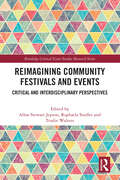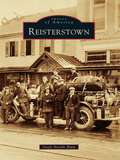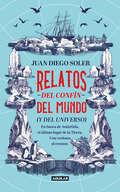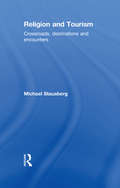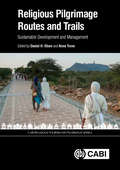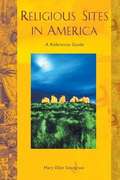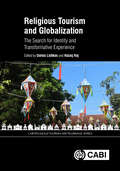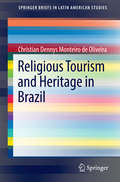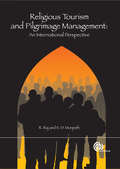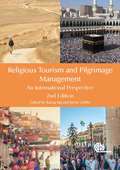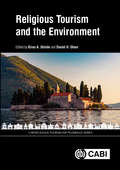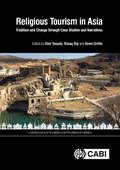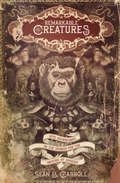- Table View
- List View
Reimagining Community Festivals and Events: Critical and Interdisciplinary Perspectives (ISSN)
by Trudie Walters Allan Stewart Jepson Raphaela StadlerThis book celebrates and builds on Alan Clarke (1956–2021) and Allan Jepson’s 2015 book Exploring Community Festivals and Events. It showcases how far the study of community festivals and events has come in the intervening years, and in so doing it is a response to recent calls for researchers to take a more critical approach to event studies.This is an interdisciplinary book that draws together empirical research across a wide range of community event types, sizes and within diverse communities. Chapters in this book are grouped into four themes that highlight the breadth and depth of work being done: reviving and maintaining tradition(s); a focus on belonging; challenges and tensions; and innovations in teaching and research. Another of its core strengths is its international perspective – the book encompasses research from around the world including Turkey, Portugal, Greece, India, the UK, the US, Austria and New Zealand. There is also a diverse range of theoretical lenses applied to the study of community events, and some innovative methodologies used to achieve research aims and objectives.This volume will appeal to students and researchers in the fields of critical event studies, cultural studies, place-making, tourism, music, sociology and geography. Several chapters also provide insights and key learnings for those lecturing and working in event management and industry professionals.
Reinventing the Local in Tourism: Producing, Consuming and Negotiating Place
by Greg Richards Antonio Paolo RussoThis book investigates the way localities are shaped and negotiated through tourism, and explores the emerging success of local peer-produced hospitality and tourism services which are transforming the tourist experience. Tourists are now being brought into much closer contact with locals and have new opportunities to experience the community at their destination. This book examines these place experiences and travel-sharing arrangements that have now spread globally due to the use of social communication platforms such as Airbnb. It analyses the existence of global communities of 'place experts' that are redefining the organisational structures, value systems, market opportunities, affordabilities and geographies in travel and tourism. This volume brings together the work of established tourism scholars as well as early career researchers and is one of the first books to examine the global-local relationship at tourism destinations and the way that the rapidly developing field of peer-to-peer tourism is transforming tourist destinations.
Reinventing the Museum: The Evolving Conversation on the Paradigm Shift
by Gail AndersonReinventing the Museum: The Evolving Conversation on the Paradigm Shift offers 44 seminal articles representing the changing perspectives about the role of museums in contemporary times. The book includes iconic pieces from the 20th century and presents the latest thinking of the past decade. The book begins with foundational writings that provide a thorough history of museum thought and theory. With this context established, Anderson presents articles that trace the emerging ideas in 21st-century museum studies on public engagement, frameworks, and leadership. In conjunction with introductory material and recommended additional readings, these articles will help students grasp the leading ideas and the essentials of the dialogue taking place in the museum field.
Reise-Sprachführer Japanisch für Dummies (Für Dummies)
by Eriko SatoMit diesem Büchlein sind Sie für die nächste Reise nach Japan gerüstet. Ob Sie in Tokio in einer Shopping Mall einkaufen, in Kyoto in einer Bar Sushi bestellen oder in Osaka über das Wetter plaudern: Hier finden Sie die passenden Sätze für die jeweilige Situation. Ganz nebenbei erfahren Sie das Wichtigste über die japanische Grammatik und bekommen viele Tipps für die richtige Aussprache.
Reisterstown
by Gayle Neville BlumBefore it was a colonial village, Reister's Town was home to tribes of the Susquehanna who lived and hunted plentiful wildlife amidst the dense primeval woods. Travelers journeyed on narrow Native American trails from remote areas through what is now Reisterstown while on their way to the nearby bustling harbor in Baltimore Town. Dirt roads afforded a tiresome trip, and a man's throat would easily become parched from the dust. John Reister, an enterprising German immigrant, was one of these early travelers. Reister recognized that the area, only a day's travel from Baltimore, would make an ideal site for an inn where weary travelers could rest and recoup. In 1758, Reister founded the town on 20 acres that the Calverts had granted him. Soon after, in 1768, Daniel Bower, a Revolutionary War colonel, settled on nearby land and built a tavern reputed to have accommodated George Washington. By 1800, Reister's Town was a busy community boasting shops, a tannery, blacksmith, inn, and taverns, which were all vital to the growth of the town and nearby communities.
Relación de un viaje al Río de la Plata
by Acarete Du BiscayAcarete du Biscay landed in Buenos Aires in spring of 1658. The story of his journey was published in London 40 years later. His writings concerning the journey refer to the indigenous and Spanish inhabitants, cities, trade, fertility, and wealth.
Relatos del confín del mundo (y del universo)
by Juan Diego Soler PulidoEn busca de la Antártida, el último lugar de la tierra. Una ventana al cosmos En el extremo sur de nuestro planeta se esconde un territorio que fue desconocido para los humanos durante la mayor parte de su historia: Antártida. Durante siglos, los más audaces exploradores cruzaron los océanos y protagonizaron extraordinarias hazañas en búsqueda de sus costas. Cuando sus barcos lograron sortear el embate del frío lacerante, el embrujo de sus días sin noche y la amenaza de los enormes témpanos, el que ha sido llamado "el último lugar de la Tierra" se convirtió en una obsesión. Como los astronautas en los tiempos modernos, los humanos atravesaron una nueva frontera y se internaron como hormigas en este inconmensurable desierto de hielo para coronar con sus banderas el punto más austral del mundo. Esta es su historia. Hoy, poco más de un siglo después de que los humanos llegaran al Polo Sur, Antártida se ha convertido en un centro de investigaciones, a donde llegan cada año expertos de todo el mundo para desarrollar estudios científicos que permiten entender nuestro planeta y el universo. El astrofísico colombiano Juan Diego Soler fue uno de ellos. En 2010 aterrizó por primera vez en esas gélidas planicies para, con el apoyo de la NASA y la Fundación Nacional de Ciencias de los Estados Unidos, lanzar a la estratósfera un telescopio robótico impulsado por un globo de helio y ver la luz más allá de las estrellas. Esta también es su historia. Relatos del confín del mundo (y del universo) es un viaje a través de palabras, mapas e imágenes a uno de los lugares más misteriosos de la Tierra, el hogar de millones de pingüinos y miles de ballenas y focas. Es una travesía a un terreno inhóspito e inhumanamente frío, en compañía de quienes arriesgaron su vida en nombre de la exploración y de quienes hoy regresan allí en nombre de la ciencia.
Relentless
by Dean Stott'Dean's journey from the Special Boat Service to intrepid adventurer is truly inspirational.' - Sir Ranulph Fiennes'An extraordinary tale of courage and adventure. Dean's story is inspirational.' - Levison Wood'Dean's relentless determination to help those who face many mental health battles is incredible and admirable - he's a hero to many.' - Bear GryllsFor readers of Ant Middleton, Jason Fox, Brian Wood, Bear Grylls and Billy Billingham comes the extraordinary, inspirational story of Special Boat Service soldier and adventurer Dean Stott.Everybody has heard the SAS motto that who dares wins, but special forces warrior Dean Stott also lives his life by another powerful mantra - that of the relentless pursuit of excellence. In 16 years of service, Dean rose to the top of Britain's fighting force, taking part of some of the most daring and dangerous operations in the war on terror, and then in the private security force, where missions included him singlehandedly evacuating the Canadian Embassy in Libya.But then, following a horrific parachuting accident, Dean's dream career was cut short, and his ethos was put to its toughest test. Just like the day when Dean's dad said that he could never make it as a soldier, Dean's doctors told him that he would never again perform at the elite level.To put it mildly, Dean disagreed, but even those that knew him were staggered by the mission that he set himself - the man who didn't own a bike would cycle the Pan American Highway, a 14,000 mile route that stretches from Argentina to Alaska, passing through some of the most dangerous countries in the world. A passionate mental health campaigner, Dean decided to up the stakes further by setting himself the task of raising a million pounds for charity. With two world records also in his sights, the stage was set for Dean to rediscover the tenacity, bravery, and downright doggedness that saw him rise to the top of the Special Forces. The final curveball arrived in the shape of a wedding invitation from his old friend Prince Harry - would he make it back in time for the royal wedding, or at all? Dean Stott is Relentless, and this is his story.
Relentless
by Dean StottFor readers of Ant Middleton, Jason Fox, and SAS: Who Dares Wins, comes the extraordinary story of Special Forces soldier Dean Stott.Everybody has heard the SAS motto that who dares wins, but special forces warrior Dean Stott also lives his life by another powerful mantra - that of the relentless pursuit of excellence. In 16 years of service, Dean rose to the top of Britain's fighting force, taking part of some of the most daring and dangerous operations in the war on terror.But then, following a horrific parachuting accident, Dean's dream career was cut short, and his ethos was put to its toughest test. Just like the day when Dean's dad said that he could never make it as a soldier, Dean's doctors told him that he would never again perform at the elite level.To put it mildly, Dean disagreed, but even those that knew him were staggered by the mission that he set himself - the man who didn't own a bike would cycle the Pan American Highway, a 14,000 mile route that stretches from Argentina to Alaska, passing through some of the most dangerous countries in the world. A passionate mental health campaigner, Dean decided to up the stakes further by setting himself the task of raising a million pounds for charity. With two world records also in his sights, the stage was set for Dean to rediscover the tenacity, bravery, and downright doggedness that saw him rise to the top of the Special Forces. The final curveball arrived in the shape of a wedding invitation from his old friend Prince Harry - would he make it back in time for the royal wedding, or at all? Dean Stott is Relentless, and this is his story.(P) 2019 Headline Publishing Ltd
Religion and Tourism: Crossroads, Destinations and Encounters
by Michael StausbergThis book explores the dynamic interaction between religion and tourism in the modern world. It considers questions such as: do travellers leave their religion at home when they are touring – and what happens if not? what are the relationships between tourism and pilgrimage? what happens to religious performances, places and festivals that function as tourism attractions? Other chapters examine religious theme parks, wellness and spa tourism, the roles played by tourist guides, guidebooks and religious souvenirs, and the role of tourism as a major arena of religious encounters in the contemporary world. Surveying the growing body of work in the field, Michael Stausberg argues that tourism should be a major focus of research within religious studies.
Religious Pilgrimage Routes and Trails: Sustainable Development and Management (CABI Religious Tourism and Pilgrimage Series)
by Rana P. Singh Dallen J. Timothy Jaeyeon Choe Dr Daniel H Olsen Associate Professor Anna Trono Raffaella Afferni Stephen William Boyd Valentina Castronuovo Tomasz Duda Vreny Enongene Carla Ferrario Paul R. Fidgeon Brian J. Hill Michael Hitchcock Marco Leo Imperiale Darius Liutikas Rubén C. Lois-González Pravin S. Rana Pilar Taboada-de-Zúñiga Romero Rodrigo Espinoza Sanchez Xosé M. Santos Kiran A. Shinde Gabriella Trombino Greg WilkinsonFor millennia people have travelled to religious sites for worship, initiatory and leisure purposes. Today there are hundreds, if not thousands, of religious pilgrimage routes and trails around the world that are used by pilgrims as well as tourists. Indeed, many religious pilgrimage routes and trails are today used as themes by tourism marketers in an effort to promote regional economic development. Providing a holistic approach to religious pilgrimage routes and trails, this book: - Addresses important conceptual themes such as sustainable local development, regional economic development, heritage identity and management, and promoting environmentally friendly practices; - Includes global case studies to help transfer theory into good practice; - Calls for further discussion of the importance of better planning, management, and maintenance of these routes and trails, so that the positive benefits of this type of tourism development can be fully realized. An important resource for those interested in religious tourism and pilgrimage, this book is also an invaluable collection for academics and policy-makers within heritage tourism and regional development.
Religious Pilgrimage Routes and Trails: Sustainable Development and Management (CABI Religious Tourism and Pilgrimage Series)
by Rana P. Singh Dallen J. Timothy Jaeyeon Choe Dr Daniel H Olsen Associate Professor Anna Trono Raffaella Afferni Stephen William Boyd Valentina Castronuovo Tomasz Duda Vreny Enongene Carla Ferrario Paul R. Fidgeon Brian J. Hill Michael Hitchcock Marco Leo Imperiale Darius Liutikas Rubén C. Lois-González Pravin S. Rana Pilar Taboada-de-Zúñiga Romero Rodrigo Espinoza Sanchez Xosé M. Santos Kiran A. Shinde Gabriella Trombino Greg WilkinsonFor millennia people have travelled to religious sites for worship, initiatory and leisure purposes. Today there are hundreds, if not thousands, of religious pilgrimage routes and trails around the world that are used by pilgrims as well as tourists. Indeed, many religious pilgrimage routes and trails are today used as themes by tourism marketers in an effort to promote regional economic development. Providing a holistic approach to religious pilgrimage routes and trails, this book: - Addresses important conceptual themes such as sustainable local development, regional economic development, heritage identity and management, and promoting environmentally friendly practices; - Includes global case studies to help transfer theory into good practice; - Calls for further discussion of the importance of better planning, management, and maintenance of these routes and trails, so that the positive benefits of this type of tourism development can be fully realized. An important resource for those interested in religious tourism and pilgrimage, this book is also an invaluable collection for academics and policy-makers within heritage tourism and regional development.
Religious Sites in America
by Mary Ellen SnodgrassProfiles the diversity of American religious expression, encompassing active religious centers and some 160 worship groups in all 50 states, from cathedrals to store-front chapels. Entries give information on each site's location, origin, and history, as well as its size, accessibility, purpose, and influence. Telephone, fax, and electronic contacts are also given. A multitude of beliefs and practices are represented, including Navajo sand painting, Messianic Judaism, ki healing, evangelism, and peyotism. Includes a detailed timeline charting the growth of religious expression in America, a glossary, and b&w photos for many entries.
Religious Tourism and Globalization: The Search for Identity and Transformative Experience (CABI Religious Tourism and Pilgrimage Series)
by Dr Nour Farra-Haddad Vitor Ambrósio Alison T. Smith Jaffer Idris Dimitrios Mylonopoulos Ricardo Nicolas Progano Silvia Aulet Serrallonga Spyridon Parthenis Dr Dino Bozonelos Polyxeni Moira Caglar Bideci Mujde Bideci Elzbieta Bilska-Wodecka Stephen F. Haller Antonietta Ivona Isilda Leitão Eleanor O’Keeffe Donatella PriviteraIs it possible to identify the positive and negative effects of globalization on religious tourism or to estimate the transformation of the internal and external constructs of pilgrimage by these effects? In order to address these questions, this book highlights the importance of the search for identity and transformative experience during religious tourism. It also looks at how, recently, globalization has played a part in the changes of the concept of personal and social identity and the transformative experience of pilgrimage. The chapters, consisting of carefully selected case studies, analyse possible effects including the adoption of different new rituals, new pilgrims' values, changes of tradition, acceptance of technologic innovations, development of new business models, and other environmental and sociocultural changes. The book provides: · a conceptual framework for understanding the impacts of globalization; · integrated cross-disciplinary approaches; and · an insight into major religious travel practices in the age of identity challenges and worldwide transformations. It will be suitable for researchers and students of religious tourism, pilgrimage, identity tourism, as well as related subjects such as sociology, anthropology, psychology, theology, history and cultural studies.
Religious Tourism and Heritage in Brazil
by Christian Dennys Monteiro OliveiraThe book reflects on the current dimensions of tourism and patrimony in Brazil. It presents cultural realities as resources for the resolution of tensions between different communities and the establishment of their identities. The book also presents memories and forgotten traditions that are important in the representation of places and cultures. It questions religious systems and their dynamic interface with the occupation of cultural spaces and the interpretation of touristic practices in Brazil. The topics discussed include pilgrimages, sanctuaries, symbolic vectors, and religious festivals.
Religious Tourism and Pilgrimage Festivals Management: An International Perspective
by Razaq Raj Nigel D. MorpethIn case studies, researchers in tourism from Europe, China, Australia, and Canada present personal, theoretical, and empirical insights into pilgrimage, religion, and tourism. They explore increasing linkages and interconnections between shared sacred and secular spaces; religious and pilgrimage activity related to ancient, sacred, and emerging tourist destinations; and new forms of pilgrimage, faith systems, and quasi-religious activities.
Religious Tourism and Pilgrimage Management: An International Perspective (2nd Edition)
by Razaq Raj Neil Robinson Ian Rotherham Alan Clarke Dr Nour Farra-Haddad Carlos Fernandes Silvia Aulet Vitor Ambrósio Elizabeth Ifeyinwa Benson Nigel Bond Miguel Brázio Geoffrey Skoll Dr Dolors Vidal Ruth Blackwell Hadil Faris Dr Maria Leppakari Michael O’ Regan Yasin Bilim Jorge Coelho Jaeyeon Choe Tahir Rashid Samson Olawale Fadare Sevde Düzgüner Maximiliano Korstanje Lluis Prats Vincent Zamitt Anna Trono Kevin Griffin Agnes RaffayWithin the past 10 years 'Religious Tourism' has seen both economic and education-sector growth on a global scale. This book addresses the central role of religious tourism and interrelationships with other aspects of pilgrimage management. It provides practical applications, models and illustrations and looks at secular and sacred spaces on a global stage. The second edition sees the introduction of a new structure and the addition of new international case studies. It is an invaluable reference for academics, students and practitioners and is a timely text on the future of faith-based tourism and pilgrimage.
Religious Tourism and Pilgrimage Management: An International Perspective (Cabi Religious Tourism And Pilgrimage Ser.)
by Neil Robinson Ian Rotherham Alan Clarke Dr Nour Farra-Haddad Carlos Fernandes Silvia Aulet Vitor Ambrósio Elizabeth Ifeyinwa Benson Nigel Bond Miguel Brázio Geoffrey Skoll Ruth Blackwell Hadil Faris Dr Maria Leppakari Michael O’ Regan Yasin Bilim Jorge Coelho Jaeyeon Choe Tahir Rashid Samson Olawale Fadare Sevde Düzgüner Lluis Prats Vincent Zamitt Agnes Raffay Associate Professor Anna Trono Professor Maximiliano Korstanje Dr Dolors Vidal-CasellasWithin the past 10 years 'Religious Tourism' has seen both economic and education-sector growth on a global scale. This book addresses the central role of religious tourism and interrelationships with other aspects of pilgrimage management. It provides practical applications, models and illustrations and looks at secular and sacred spaces on a global stage. The second edition sees the introduction of a new structure and the addition of new international case studies. It is an invaluable reference for academics, students and practitioners and is a timely text on the future of faith-based tourism and pilgrimage.
Religious Tourism and the Environment (CABI Religious Tourism and Pilgrimage Series)
by Kiran A. Shinde and Daniel H. OlsenThe remarkable growth in religious tourism across the world has generated considerable interest in the impacts of this type of tourism. Focusing here on environmental issues, this book moves beyond the documentation of environmental impacts to examine in greater depth the intersections between religious tourism and the environment. Beginning with an in-depth introduction that highlights the intersections between religion, tourism, and the environment, the book then focuses on the environment as a resource or generator for religious tourism and as a recipient of the impacts of religious tourism. Chapters included discuss such important areas as theological views, environmental responsibility, and host perspectives. Covering as many cultural and environmental regions as possible, this book provides: -An in-depth yet holistic view of the relationships between religious tourism and the environment; -A conceptual framework that goes beyond listing potential environment impacts; -A strong focus on explaining the universality of the deeper environmental issues surrounding sacredness and sacred places; -A discussion of the role of disease and health-related issues at mass religious gatherings. From a global writing team and featuring case studies spanning Europe and Asia, this book will be of great interest to researchers and students of tourism and religious studies, as well as those studying environmental issues.
Religious Tourism and the Italian Economy, 1870—1950: The Development of Catholic Pilgrimages as a Mass Phenomenon (Palgrave Studies in Economic History)
by Luciano Maffi Giovanni Gregorini Riccardo SemeraroThis book addresses a little-studied area of the history of tourism, religious tourism, and pilgrimage and introduces a comprehensive economic analysis of their development from elite pursuits to a mass phenomenon. Focusing on Rome, Lourdes, and the Holy Land as destinations, the book showcases religious tourism as a key precursory factor in mass tourism in Italy and Europe. Departing from conventional historiographical timeframes, the authors demonstrate that the surge in tourism during the Italian &“economic miracle&” did not arise ex novo at that time but was part of a longer process of transformation originating prior to the Second World War. Diverse factors are discussed such as the social and economic role of the Catholic Church, its relationship to tourism, revolutions in transport technologies, rising wages, and increasing leisure time. Key questions are explored regarding religious travel (who, when, how) and how it gained momentum in the first half of the twentieth century. Drawing on a wealth of unpublished sources, many from the Vatican Archives, the book uncovers new religious, social, and cross-cultural perspectives and contexts for studying the economic history of tourism.
Religious Tourism in Asia: Tradition and Change through Case Studies and Narratives (CABI Religious Tourism and Pilgrimage Series)
by Razaq Raj Kevin Griffin Dr Shin YasudaThe Asia-Pacific region is considered the world's religious core, with the greatest number of pilgrims and travellers to religious events for both international and domestic tourism. It is estimated that there are approximately 600 million national and international religious and spiritual voyages in the world, of which over half take place in Asia. This book focuses on tourism and sacred sites in Asia. Contemporary case studies of religious and pilgrimage activities provide key learning points and present practical examples from this 'hub' of pilgrimage destinations. They explore ancient, sacred and emerging tourist destinations and new forms of pilgrimage, faith systems and quasi-religious activities. It will be of interest to researchers within religious, cultural, heritage and Asian tourism. Key features include: - An Asian perspective on a growing area of tourism. - Case studies from across the continent. - Full-colour images of pilgrimage sites and key destinations bring the topic to life.
Religious Tourism in Asia: Tradition and Change through Case Studies and Narratives (CABI Religious Tourism and Pilgrimage Series)
by Razaq Raj Kevin Griffin Shin YasudaThe Asia-Pacific region is considered the world's religious core, with the greatest number of pilgrims and travellers to religious events for both international and domestic tourism. It is estimated that there are approximately 600 million national and international religious and spiritual voyages in the world, of which over half take place in Asia. This book focuses on tourism and sacred sites in Asia. Contemporary case studies of religious and pilgrimage activities provide key learning points and present practical examples from this 'hub' of pilgrimage destinations. They explore ancient, sacred and emerging tourist destinations and new forms of pilgrimage, faith systems and quasi-religious activities. It will be of interest to researchers within religious, cultural, heritage and Asian tourism. Key features include: - An Asian perspective on a growing area of tourism. - Case studies from across the continent. - Full-colour images of pilgrimage sites and key destinations bring the topic to life.
Relocating to New York City and Surrounding Areas: Revised and Updated 2nd Edition
by Ellen R. ShapiroMaking the Big Move to the Big Apple Just Got Easier!Moving to New York City and its neighboring areas can be overwhelming and expensive. What you need is a comprehensive and authoritative guide to the diverse neighborhoods, cultures, and lifestyles-not to mention the entertainment options, trends, and hidden gems that are the heartbeat of your new home. In Relocating to New York City and Surrounding Areas, Revised and Updated 2nd Edition, you get an insider's view of New York plus all the practical information you need to make your transition smooth and more affordable, including:*How to find a place to live-fast, and in a neighborhood you'll love *Where to look for a job *How much it costs to live in the city and its environs*Where to find the best restaurants and entertainment in town *How to get around New York *How to move, ship, and store your stuff easily and affordablyNot just a neighborhood directory for newcomers, this is also a bible for those already living here, offering advice on the best schools, bargain shopping, discount tickets, and free events. Whether you're planning a move or already here, you'll want to keep this definitive guide in reach for the handy checklists, savvy tips, website listings, and fresh advice. Bursting with up-to-date statistics on every neighborhood and information on everything from post offices and grocery stores to health clubs and theaters, Relocating to New York City and Surrounding Areas will help you negotiate the city like a local on your very first day.Learn about New York's hottest neighborhoodsGreenwich VillageSoHo East Village Morningside Heights Park Slope Williamsburg Cobble Hill Brooklyn Heights Dumbo AstoriaFrom the Trade Paperback edition.
Remarkable Creatures: Epic Adventures in the Search for the Origins of Species
by Sean B. CarrollNational Book Award Finalist: A biologist&’s &“thoroughly enjoyable&” account of the expeditions that unearthed the history of life on our planet (Publishers Weekly). Not so long ago, most of our world was an unexplored wilderness. Our sense of its age was vague and vastly off the mark, and much of the knowledge of our own species&’ history was a set of fantastic myths and fairy tales. But scientists were about to embark on an amazing new era of understanding. From the New York Times–bestselling author of The Big Picture, this book leads us on a rousing voyage that recounts the most important discoveries in two centuries of natural history: from Darwin&’s trip around the world to Charles Walcott&’s discovery of pre-Cambrian life in the Grand Canyon; from Louis and Mary Leakey&’s investigation of our deepest past in East Africa to the trailblazers in modern laboratories who have located a time clock in our DNA. Filled with the same sense of adventure that spurred on these extraordinary men and women, Remarkable Creatures is a &“stirring introduction to the wonder of evolutionary biology&” (Kirkus Reviews). &“Charming and enlightening.&” —San Francisco Chronicle &“As fast-paced as a detective story.&” —Nature
Remembering Chapel Hill: The Twentieth Century As We Lived It (American Chronicles)
by Valarie SchwartzSince the 1789 charter of the country�s first state university, Chapel Hill has attracted people from all over who found that the town was the perfect place to put down roots. In this collection, local newspaper columnist Valarie Schwartz celebrates many of Chapel Hill�s most notable residents, from the World War II veteran who came to law school after the war and ended up as president of the UNC system for thirty years to the couple from the Midwest who arrived in 1935 and spent their careers building the North Carolina Symphony Orchestra. Featuring stories of struggle and success from all walks of life, Remembering Chapel Hill is a tribute to the twentieth-century citizens who made the city what it is today: �a Southern slice of heaven.�
